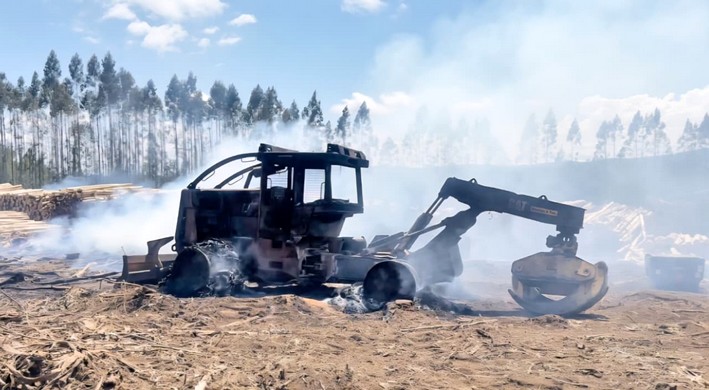The Paradigm of Forest Engineering: A Response
- By Simón Berti, President of the College of Forest Engineers, and Julio Torres Cuadros, Executive Secretary of the College of Forest Engineers
Two representatives of the College of Forest Engineers detail in a column for CIPER what they consider omissions and distortions in the debate surrounding monocultures, the forestry industry, and its environmental responsibility: "More timber, from both natural and planted forests, to contribute to the country's well-being. That is what we defend. That is our paradigm."
In a column in this same outlet, Professor Antonio Lara, attorney Monserrat Moya, and academic Mauro González call on forestry companies and related sectors—including the College of Forest Engineers A.G.—to become part of the solution regarding the conflicts generated by Chile's forestry model. Of course, the authors' call is to join the solution they identify, based on the paradigms they defend. Although they begin by acknowledging the contribution of forestry to Chile's economy and employment, as well as the improvements brought by adopting sustainable management certification, it seems this recognition is not enough to convince them that the forestry model presents a positive balance.
The authors also criticize the critical stance taken by companies and industry associations toward the bill that transforms the National Forestry Corporation (currently a private corporation) into the National Forestry Service (a future public service), as well as the wildfire prevention bill. Finally, they argue against our calls to reinstate incentives for afforestation by small and medium landowners on eroded soils—a call made not only by the College of Forest Engineers but also by other industry groups (such as the Small and Medium Wood Industry Association, Pymemad, and the Forestry Contractors Association, Acoforag).
Their column is an opportunity to contrast visions and paradigms. First, it is important to address the authors' legal interpretation of the limitation on monoculture incentives in the Framework Law on Climate Change (LMCC). They claim that the exclusion of monocultures is absolute, with no exceptions, and that the regulation admits no alternative readings or interpretations. But this is not the case.
The exclusion is framed within the goal of achieving carbon neutrality by 2050. To this end, guidelines are defined for greenhouse gas absorption and storage as part of a long-term climate strategy. Therefore, the exclusion of monocultures applies in this context and for this specific objective. It is not, as the authors claim, an absolute exclusion without exceptions. The authorities of the Ministry of Agriculture are not bound in terms of afforestation. It is entirely possible to promote incentives for small and medium landowners with eroded soils, without species exclusion, to address the timber supply crisis for small and medium enterprises and encourage the replacement of materials like cement and steel in construction. This instrument would not be part of a long-term climate strategy, and the carbon sequestration would not count toward the 2050 neutrality goal. Differentiated initiatives can be promoted, and certainly, not all state actions must fall under the LMCC. This law is not the General Constitution of the Republic and does not regulate every aspect of the country's productive and social activity.
On the other hand, the law states in Article 2 that among the principles guiding it are cost-effectiveness and coherence. Paradoxically, the exclusion of monocultures considers neither principle, as they are the most cost-effective option for CO2 capture and storage [DROPPELMANN et al. 2019]. Additionally, the principle of coherence is not respected, since the same Ministry of the Environment in 2014 identified afforestation as one of the initiatives with the greatest mitigation potential, later incorporating it into the measures outlined in the 2015 NDCs and their 2020 update, which include planting 200,000 hectares of new forests by 2030. And now, the same Ministry of the Environment undermines this strategy by excluding monocultures. The exclusion is incoherent from any angle, not even by appealing to "common sense." Nor is it coherent to claim that the forestry-based climate strategy can rely entirely on native forest restoration.
Certainly, the figures presented by the authors regarding subsidies for sustainable management, native forest recovery, and afforestation with native species for small and medium landowners—amounting to 51,000 hectares for the period 2021-2023—are surprising, as the official figures from CONAF's public accounts show much lower numbers: 2,791, 2,814, and 3,347 hectares for 2021, 2022, and 2023, respectively, totaling just under 9,000 hectares [CONAF 2023]. Even considering temporary programs like "+Bosques" or "Siembra por Chile," the claimed 51,000 hectares cannot be reached.
But this "legal-technical" discrepancy points to a deeper difference between the column's authors and the vision not only of the College of Forest Engineers but also of other related industry actors. The paradigm driving us, and which has also been recognized globally, is that the forestry sector must lead the transition toward a bioeconomy based on wood as the preeminent material of the 21st century, replacing fossil fuel-derived or high-environmental-footprint materials like plastic, cement, and steel. A green country is built with wood. That is our paradigm, and it is curious that the authors completely omit this crucial aspect of the forestry and environmental debate. Do they want more timber or not? Do they want to advance toward a bioeconomy through the sustainable use of natural and planted forests? Yes or no? We believe they cannot and should not evade these questions with voluntarist appeals, as if forests were only for contemplation and had nothing to contribute to climate solutions through sustainable use.
Precisely, wood is one of the main protagonists of a climate solution. Not only due to carbon storage in standing trees but also through the storage in wood products they provide. Moreover, a strategy based on increasing the use of timber from native forests under sustainable management would have a social impact that cannot be dismissed. Recently, CONAF updated its registry of native forest owners, increasing from 90,000 initially recorded to over 200,000. It would be interesting to hear what these thousands of owners think about the authors' strategy of favoring an approach based mostly on restoring degraded forests rather than integrating their forests into productive management with state support.
More timber, from both natural and planted forests, to contribute to the country's well-being. That is what we defend. That is our paradigm.
Regarding the bills mentioned and supported by the columnists, in both cases, the College of Forest Engineers has been invited to testify before Congress. We believe the wildfire bill does not point in the right direction and, as currently drafted, cannot be unconditionally supported. Among its most significant omissions is the lack of a focus on preventing wildfire occurrence, as well as criminalizing landowners with introduced species who suffer fires caused by third parties—often intentionally. In fact, intentionality is an aspect the authors have systematically omitted from the wildfire debate, even though the CR2 report following the 2017 fires states that the intentionality rate in the Biobío and La Araucanía regions that season was 50%. Additionally, CONAF has indicated that in the Biobío Region, 57% of investigated fires in the 2023 season were intentional—nearly six out of ten. What paradigm do they invoke to explain these figures? The high rate of wildfire-affected areas in the last decade (over 700,000 hectares of plantations and 600,000 hectares of native forests and scrublands) should prompt reflection on the best strategies for control, focusing on reducing occurrences. That is our focus, and it will remain so.
Regarding the bill creating the National Forestry Service, we have also identified deficiencies that need addressing and have proactively participated in Congressional committees and technical roundtables to improve the draft. That is our task, and we are committed to it. Among other things, we have insisted on unequivocally assigning all aspects of public forest management to the new forestry service, eliminating any potential regulatory subordination of forests and other vegetation to the recently created Biodiversity Service. Collaboration must begin by recognizing which agency is responsible for forest management—and that must be the forestry service.
We will continue working, alongside all sector stakeholders, toward the paradigm of a bioeconomy and sustainability based on the sustainable use of forest resources, whether natural or planted. Our call is for everyone to unite behind this paradigm.
Source:CiperChile.cl

















